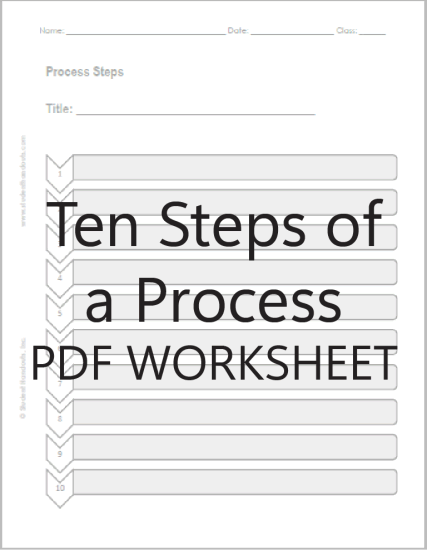| Steps of a Process Worksheet |
|---|
| www.studenthandouts.com ↣ Graphic Organizers ↣ Graphic Organizers: Processes |
 |
    |
|
Ten steps of a process: Numbered arrows lead from one step to another, with plenty of room for students to describe each step. Click here to print.
Learning how to describe the steps in a process is highly beneficial for students for several reasons. Clarity and Communication: The ability to articulate the steps in a process clearly is essential for effective communication. Students who can describe processes can convey information, instructions, and ideas more effectively, both in writing and in speech. Problem-Solving: Describing the steps in a process is often a crucial component of problem-solving. Students can break down complex issues into manageable steps, analyze each step, and identify where problems or inefficiencies may occur. Process Understanding: When students learn to describe processes, they gain a deeper understanding of how things work. This is particularly valuable in fields like science, technology, engineering, and mathematics (STEM), where processes underpin much of the subject matter. Procedural Knowledge: Many fields, such as laboratory experiments, computer programming, culinary arts, and technical skills, require procedural knowledge. Students who can describe the steps in a process are better equipped to apply their knowledge in practical settings. Sequence and Order: Understanding the steps in a process reinforces the importance of sequence and order. Students learn how certain actions or events must occur in a specific order to achieve a desired outcome. Critical Thinking: Describing processes often involves analyzing each step critically. Students must consider cause-and-effect relationships, dependencies between steps, and potential variations in the process. Standardization: Learning to describe processes is relevant in industries that require standardization and quality control. Students gain an appreciation for why standard procedures are essential in certain fields. Interdisciplinary Learning: Describing processes is a skill that can be applied across subjects. Whether it's understanding historical events, literary narratives, or scientific experiments, the ability to describe processes promotes interdisciplinary learning. Project Management: Students can use process descriptions to plan and manage projects effectively. They learn how to set goals, allocate resources, and track progress. Problem Prevention: By understanding and describing processes, students can anticipate potential problems or errors at various stages. This proactive approach can lead to better outcomes and improved efficiency. Quality Control: In fields such as manufacturing, healthcare, and software development, quality control relies on well-defined processes. Students learn about the importance of quality control and how to implement it. Real-World Application: The ability to describe processes is valuable in professional settings. Students who learn this skill are better prepared for careers in fields like engineering, healthcare, logistics, management, and more. Learning Transfer: The skill of describing processes can be transferred to various learning contexts. It enhances students' ability to tackle new problems and adapt their knowledge to different situations. Self-Management: Students who can describe processes have better self-management skills. They can plan their tasks, track progress, and troubleshoot issues independently. Learning how to describe the steps in a process equips students with a wide range of skills, from effective communication to problem-solving and critical thinking. These skills are valuable both in academic settings and in preparing students for future careers and real-world challenges. |
| www.studenthandouts.com ↣ Graphic Organizers ↣ Graphic Organizers: Processes |








